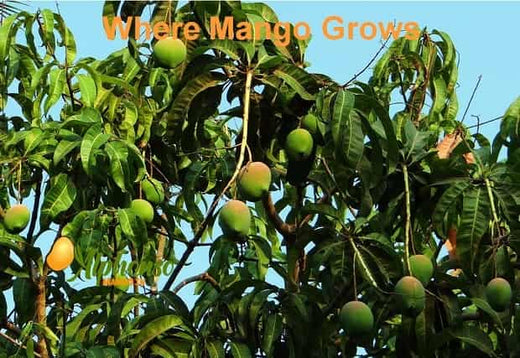- Mangoes grow in tropical and subtropical climates worldwide, thriving in warm, sunny regions.
- Originally from South Asia, they are now cultivated in India, Pakistan, Thailand, Mexico, Brazil, and the U.S.
- Mango trees can grow up to 40 feet tall, producing sweet, juicy fruit in the right conditions.
Table of contents
Where Mango Grows
When you pass through the roads of Konkan from Mumbai, you will always feel where you are, where you have landed yourself.
Mangoes grow in tropical and subtropical climates around the world.
They are native to South Asia, but they are now grown in many other countries, including India, Pakistan, Thailand, Mexico, Brazil, and the United States.
They grow on trees, reaching a height of up to 40 feet.

The plants typically produce fruit after 3-5 years of planting. They can be harvested once a year, and the harvest season varies depending on the location.
They are a popular fruit because they are delicious and nutritious.
They are a good source of vitamins A, C, and E, as well as minerals such as potassium and magnesium, and they are also a great source of dietary fibre.
It is a lush green land where Aam Grows.
Buy Mango
The plant grows in the tropical climate of India.
They are one of many sources of this tropical fruit. It is also a significant bird housing society.
Aam Grows across India, but King of Alphonso grows in Konkan, which is now Geographical Tag Certified.
It is one of the best living things, giving multiple things to Mother Earth and the people who live on the planet.
The plant grows to a great height. Any spelling, grammar, and punctuation errors have been corrected. Nowadays, with some research, it is always pruned to maintain its size and harvest quickly.

Where mango Grows?
Where mango grows depends on climate, as these fruits need warm, tropical conditions.
India is one of the main places where mango grows, especially in Maharashtra, Gujarat, and Uttar Pradesh.
The Konkan region is famous, where mango grows in large quantities, producing Alphonso mangoes.
Where mango grows best includes countries like India, Thailand, Mexico, and the Philippines.
The humid and sunny climate of Ratnagiri is ideal where mango grows naturally.
Many farms where mango grows use organic methods to enhance fruit quality.
Regions where mango grows need well-drained soil and moderate rainfall for good yield.
Devgad and Sindhudurg are districts where mango grows to produce premium-quality Hapus mangoes.
Orchards where mango grows require regular care, pruning, and pest control to ensure a high-quality harvest.
Most areas where mango grows are located in tropical and subtropical regions around the world.
Brazil is another country where mango grows, supplying mangoes to global markets.
People often ask where mango grows best, and the answer is warm, frost-free areas.
The southern states of India, such as Karnataka and Tamil Nadu, are places where mango grows abundantly.
In the USA, Florida and California are regions where mango grows due to their warm climate.
In Africa, countries like Egypt and Kenya are locations where mango grows successfully.
Pakistan is another country where mango grows, producing varieties like Sindhri and Chaunsa.
The Middle East has select farms where mango grows, but production is limited due to arid conditions.
The Caribbean islands are places where mango grows, offering exotic tropical mango varieties.
Scientists study soil and climate conditions where mango grows to improve farming techniques.
Greenhouses provide controlled environments where mango grows even in non-tropical regions.
Mango Tree Height
Most well-grown plants have a height of 70 feet to 100 feet or even more.
The plant's circumference can spread across 28 to 38 feet or more.
Nowadays, with the latest technology in mind, these trees are cultivated with pruning technology, which makes harvesting them easier.
The leathery leaves, which last more than a year on the tree, are 4 to 18 inches long and have a leathery texture.
Flowers called motor in Marathi blossom at the end with groups of 4 to 16 inches long.
The plant flowers are small, with white petals and a mildly sweet aroma.
Honey bees and insects pollinate flowers, and less than 1 per cent of the flowers will mature to form a fruit.
India is Mango's first country to produce 50% of the world's total produce.
Several countries produce this tropical fruit, including Mexico, China, Pakistan, Thailand, Indonesia, the Philippines, Nigeria (planted by travelling Indians), Brazil, and Egypt.

In which season mango grows in India
This fruit tree starts flowering from December to February and bears fruits from February.
But the proper season of Aam in India is from March to June, and some varieties of these start in July or August, like Dasheri. While
Alphonso Mango season is up until the end of May.
Difference between Mango Puree and Mango Pulp
Where does mango grow best?
Mango grows best in warm, tropical, and subtropical climates with plenty of sunlight. India, Thailand, Mexico, and Brazil are the top producers of mango.
Can mango grow in colder regions?
Mango trees need warm temperatures and cannot survive frost. However, in some colder regions, they can grow in greenhouses or controlled environments.
Which states in India grow the most mangoes?
In India, mangoes grow mainly in Maharashtra, Uttar Pradesh, Gujarat, Karnataka, and Tamil Nadu, with Ratnagiri and Devgad being famous for Alphonso mangoes.




